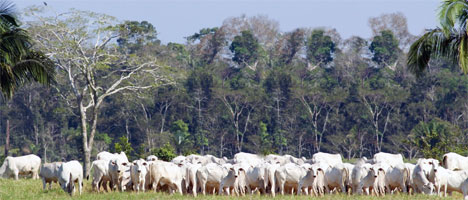Land Ecosystems and Hydrology

Contacts, for more information:
Understanding the influence of humans on the biosphere and the global climate system is one of the most pressing challenges in the Earth sciences. Land is a key component of the Earth system. Changes in land characteristics are extremely important for their effects on climate, terrestrial ecosystems, and simply because of the direct effects on the societies that live on that land. Our focus is terrestrial biogeochemical and hydrological cycles in both natural systems and those perturbed by human activity.
The water cycle provides an especially strong link between ecosystems and climate. Plants need water. Where the ground is watered well by rainfall, plant life is abundant; where rainfall is scarce, plant life is sparse. Conversely, plants exert enormous control over the water cycle. More than half of precipitation that falls on land is returned to the atmosphere, with most of it traveling from roots through plant tissue to leaves, from which it evaporates. Changes in vegetation cover influence the water cycle and climate, and the future response of the water cycle to climate change depends critically on how plants operate under changing conditions.
Collaborative GFDL, Princeton, and USGS Research
Scientists from GFDL, Princeton University Cooperative Institute for Climate Science, and U.S. Geological Survey are working collaboratively to address a set of important and linked scientific questions that bear directly upon global environmental change and associated policy issues:
- What are the past, current, and likely future global distributions and strengths of terrestrial sources and sinks of carbon dioxide?
- What are the effects, separately and collectively, of changes in land-use, climate, nitrogen deposition and fertilization, and atmospheric composition on exchanges of water, energy and biogeochemical tracers between land, atmosphere and oceans?
- What is the potential of alternative management strategies to avoid, slow, or mitigate potentially adverse future changes in the Earth system?
Our strategy is to develop and apply advanced land models, forced by atmospheric observations and coupled to GFDL comprehensive climate models and ESMs, to answer these questions. Our intent is to reduce the major scientific uncertainties about the terrestrial carbon sink, its dependence on nutrients, and its feedback onto the larger climate system.
Land Use and Land Cover Change
Land use and land cover change (LULCC) has been long recognized as one of the factors affecting climate. About one-third to one-half of the land surface has been disturbed and modified by humans, and this fraction is going to increase in the future. Anthropogenic land use affects climate through two major pathways. First, human land use activities decrease the amount of carbon stored in the terrestrial system, and contribute to the growth of the atmospheric concentrations of greenhouse gases, such as carbon dioxide, methane, and nitrous oxide (i.e. biochemical effect), and to the anthropogenic warming of climate.
Second, human land use activities modify the physical properties of the surface, such as albedo, roughness length, and accessibility of soil moisture for evapotranspiration, contributing to changes in the near-surface climate (i.e. biophysical pathway). For example, the well-known “urban heat island” effect (i.e., cities are generally hotter than the surrounding rural areas) is largely caused by conversion of vegetated surfaces to impervious surfaces in cities. The local climate effects of LULCC in those regions become especially important for the estimates of climate change impacts on human life.
Therefore, a better understanding of biochemical and biophysical effects of LULCC is essential for better predicting changes in climate and assessing their impacts.
Biogeochemical Cycling in Terrestrial Systems
The carbon cycle has the potential to influence the climate system primarily through affecting the atmospheric concentrations of carbon dioxide (CO2) and methane (CH4), which are the two greenhouse gases primarily responsible for ongoing climate change. However, modification of the cycles of other elements, especially nitrogen and phosphorous, have major impacts on climate, either directly or indirectly altering the carbon cycle.
An important goal of the research at GFDL is to improve prognostic models of the carbon cycle including interactions with other biogeochemical cycles. This will allow us to analyze different scenarios of future emissions and land use, and examine the sensitivity of these biogeochemical cycles to the projected changes in the Earth System modeling framework.
The effect of nitrogen cycling on the land carbon cycle has been investigated with GFDL’s coupled carbon-nitrogen model LM3-N. This study showed that limited nutrient supplies such as nitrogen could limit the land carbon sink. Many ecosystems’ mechanisms and their interactions with climate are currently not well understood. Predicting future extra-tropical wetlands is particularly challenging, because their state and distribution are governed by changes in both precipitation and temperature. Our understanding of the wetland methane budget and its sensitivity to future changes is limited. Large parametric uncertainties cause current models to vary widely in their predictions. The next generation of GFDL land models, LM4, includes a number of innovative features which will enable GFDL scientists to explore and quantify the uncertainty in terrestrial biogeochemical cycling.
Research Highlights
- Uneven consequences of global climate mitigation pathways on regional water quality in the 21st century
- Abrupt loss and uncertain recovery from fires of Amazon forests under low climate mitigation scenarios
- The GFDL Earth System Model version 4.1 (GFDL-ESM4.1): Model description and simulation characteristics



